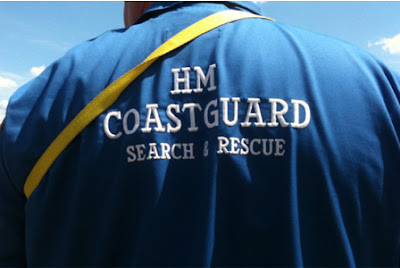I had a lovely Christmas present from Mum and Dad. It was an ‘Overboard 30 Lt waterproof rucksack'. I’d been looking at one for some time umming and arring whether to get one or not. I have another over the shoulder overboard roll top waterproof bag and it has been excellent.
The rucksack is 100% waterproof and suitable for quick submersion but not for a prolonged underwater experience! It is one main compartment with a small zipped pocket inside for keys etc. The back panel is padded at shoulders and lumber area and there are padded shoulder straps, a chest strap and a waist belt. The back panel has an air flow design.
It has a roll top which clips in one of two ways – either together or down the sides of the sac. Apparently the sac will float if dropped into the water and protects everything within from sand, dirt, water and dust. With a large elasticated mesh outer pocket for water bottle or sun-cream, a top carrying handle and reflective patches so it can be easily seen in torch light, its construction seems robust with welded seals.
So that’s a brief description but what about first impressions?
Well. I’m impressed with the build quality and toughness of the material. All seams are fully welded. It has an excellent array of adjustable straps and is comfortable to wear although I’ve yet to try it fully packed. The bungee drawstrings across the front of the sac are very good for holding waterproofs; the elasticated pocket holds my sigg water bottle and the internal pocket is big enough for keys, mobile phone etc.
Sealing the pack up was easy; the normal way we all know across the top and then a way of fastening using side clips illustrated in the diagrams below from the overboard website.
One side buckle is non moveable; the other is adjustable and I found this a little fiddly at first. Another slight bugbear is one I have with all one compartment sacs. It’s a nightmare rummaging around to find anything in the main compartment, especially small things!
I intend using it as a daypack to hold packed lunches, flasks, spare hat, gloves and sunnies and sun creams etc, etc. On camping trips – it will hold spare clothes, sleeping bag, bivvy bag etc. I think it will be an amazing piece of kit and when I have given it a road test or two I’ll report back further. In the meantime, Mum, Dad, a wonderful present – which will remind me of you both each time I’m on Arwen. Thank you! I love it – a brilliant present.
Steve
PS
One of my sisters gave me a musto sailing baseball cap as well which has a clip that attaches it to your collar. My wife bought me a sealskinz bush hat as well. Again really thoughtful presents. I am a lucky man to have family who think about my needs
Mine is identical to this one except it is all one colour - black.
The rucksack is 100% waterproof and suitable for quick submersion but not for a prolonged underwater experience! It is one main compartment with a small zipped pocket inside for keys etc. The back panel is padded at shoulders and lumber area and there are padded shoulder straps, a chest strap and a waist belt. The back panel has an air flow design.
It has a roll top which clips in one of two ways – either together or down the sides of the sac. Apparently the sac will float if dropped into the water and protects everything within from sand, dirt, water and dust. With a large elasticated mesh outer pocket for water bottle or sun-cream, a top carrying handle and reflective patches so it can be easily seen in torch light, its construction seems robust with welded seals.
So that’s a brief description but what about first impressions?
Well. I’m impressed with the build quality and toughness of the material. All seams are fully welded. It has an excellent array of adjustable straps and is comfortable to wear although I’ve yet to try it fully packed. The bungee drawstrings across the front of the sac are very good for holding waterproofs; the elasticated pocket holds my sigg water bottle and the internal pocket is big enough for keys, mobile phone etc.
Sealing the pack up was easy; the normal way we all know across the top and then a way of fastening using side clips illustrated in the diagrams below from the overboard website.
One side buckle is non moveable; the other is adjustable and I found this a little fiddly at first. Another slight bugbear is one I have with all one compartment sacs. It’s a nightmare rummaging around to find anything in the main compartment, especially small things!
I intend using it as a daypack to hold packed lunches, flasks, spare hat, gloves and sunnies and sun creams etc, etc. On camping trips – it will hold spare clothes, sleeping bag, bivvy bag etc. I think it will be an amazing piece of kit and when I have given it a road test or two I’ll report back further. In the meantime, Mum, Dad, a wonderful present – which will remind me of you both each time I’m on Arwen. Thank you! I love it – a brilliant present.
Steve
PS
One of my sisters gave me a musto sailing baseball cap as well which has a clip that attaches it to your collar. My wife bought me a sealskinz bush hat as well. Again really thoughtful presents. I am a lucky man to have family who think about my needs






































































